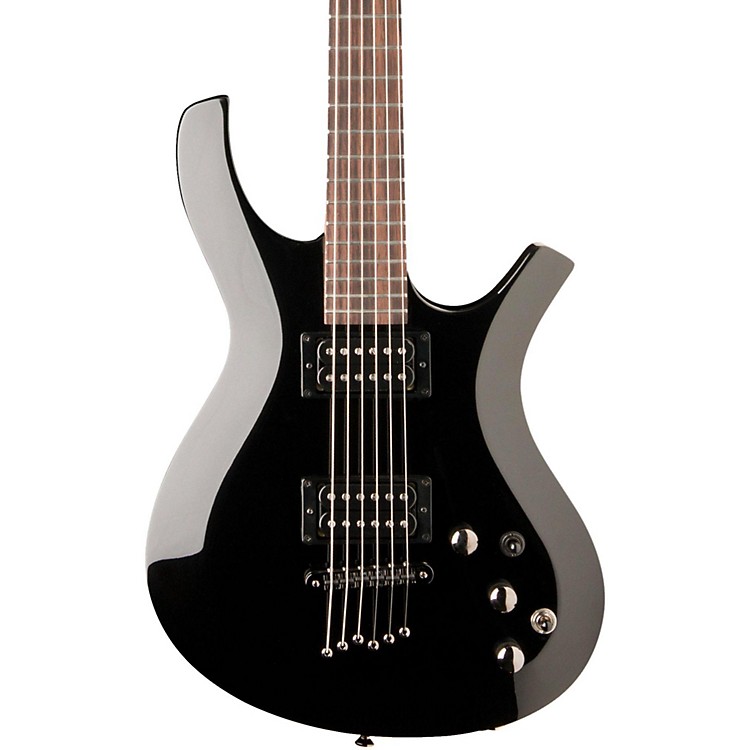


The truly unfortunate part of this story is that Barcus-Berry no longer produces the Hot Dot piezos. He said that some of the harmonics and such coming from different parts of the guitar were really nice, but some of the sounds weren't so nice and only useful for creating noise. I don't remember precisely how he controlled it all except that he used preamps for the Hot Dots, and he was able to mix the various piezo sounds coming from different parts of the guitar. (It was the cover article as he was on the cover holding the charred guitar he did this to.) But it's been decades since I read the Guitar Player magazine article in which he described it. For the neck and peghead piezos, I think he ran the wiring through the truss rod channel. In those days, Barcus-Berry made tiny little piezo pickups that were just 1/8" across called "Hot Dots", and Zappa drilled holes and stuck these Hot Dots all over the guitar.
ELECTRIC GUITAR WITH PIEZO INSTALL
Zappa then proceeded to install about nineteen (19) piezo pickups in various postions on the peghead, neck, and body of the guitar. There is a lot of controversy over just which burned Strat it was, but it's pretty certain that it wasn't the famous Monterey Pop Festival incineration. He started by building a Strat from a charred body of one of Hendrix's Strats that was burned onstage. But you asked about what others have done with multiple piezos in a guitar to get different sounds, so.įrank Zappa created what I consider to be the ultimate piezo'ed electric guitar. I don't know if this will help you or not. especially if you don't have tone shaping circuitry down the line. If you set it up, and it sounds good for the tone you are going for, then it is probably a good element to use. I've used discs from old drum toys even with nice results. As far as the difference in elements, it is a matter of experimentation for the most part, especially if you don't know the specs of the parts you are using. Changing where it is placed is nice, but also if it is not secured well then movements will be picked up pretty loudly. Then you can tape it where you want and plug it into an amp or recording device. For a less permanent and more variable set up, you can just solder the piezo element to the two leads of a shielded cable, with a plug on the other end. It seems to work pretty well this way, though you can just hook it straight to a jack without the active circuitry. In that guitar I have a "tone" pot which fades between the two pickups, then a three band active EQ, and a simple transistor based gain circuit on the output. It seems like this will pick up slightly less string noise and feedback. Placing them securely just below the bridge is a common situation. My recent "Parallel Killer" guitar built (sort of like a cigar box guitar) has two piezo elements, one focussing on high strings, and one low. I've used just basic disc piezo elements a couple of times.

STRING SPACING 52.4mm at bridge, 37.It's all a matter of taste, and what sort of response you want from your guitar.NECK DEPTH 22.6mm at 1st fret, 24.9mm at 12th fret.NECK WIDTH 43.7mm at nut, 53.3mm at 12th fret.LR Baggs/PRS piezo system with dedicated volume control. ELECTRONICS PRS 58/15 ‘S’ bridge and neck humbuckers, 3-way toggle pickup selector, volume and tone.HARDWARE PRS Adjustable Stoptail Piezo, PRS-designed nickel tuners.BUILD Laminated maple top and back with flame veneers, laminated mahogany sides, Wide Fat mahogany set neck with 10”/254mm radius ebony fingerboard, 22 medium frets, bone nut.DESCRIPTION 6-string double-cut hollowbody electric, made in China.For those considering the non-piezo version, the extra scope on offer here is worth every penny of the upcharge.
ELECTRIC GUITAR WITH PIEZO PLUS
For credible acoustic textures in a band mix, plus an array of sophisticated electric tones and inspiring new blends, this superbly made instrument would be a fine addition to any player’s arsenal. Unless you are blessed with a road crew, integrating an acoustic guitar alongside your regular electric rig can be a chore. The Hollowbody’s piezo tones are not going to replace anyone’s pre-war Martin, but that’s hardly the point. Blending in the piezo signal adds some percussive spank to our overdriven rhythm sound – it’s a trick Pete Townshend has been employing onstage for many years and it works superbly here too. Engaging a drive pedal, any suspicion that the airy construction might deliver an unfocused lead tone is quickly dispelled – there’s sustain and grit aplenty from the USA-designed, Indonesian-made 58/15 ‘S’ pickups. We send the magnetic output to a Suhr Badger.


 0 kommentar(er)
0 kommentar(er)
